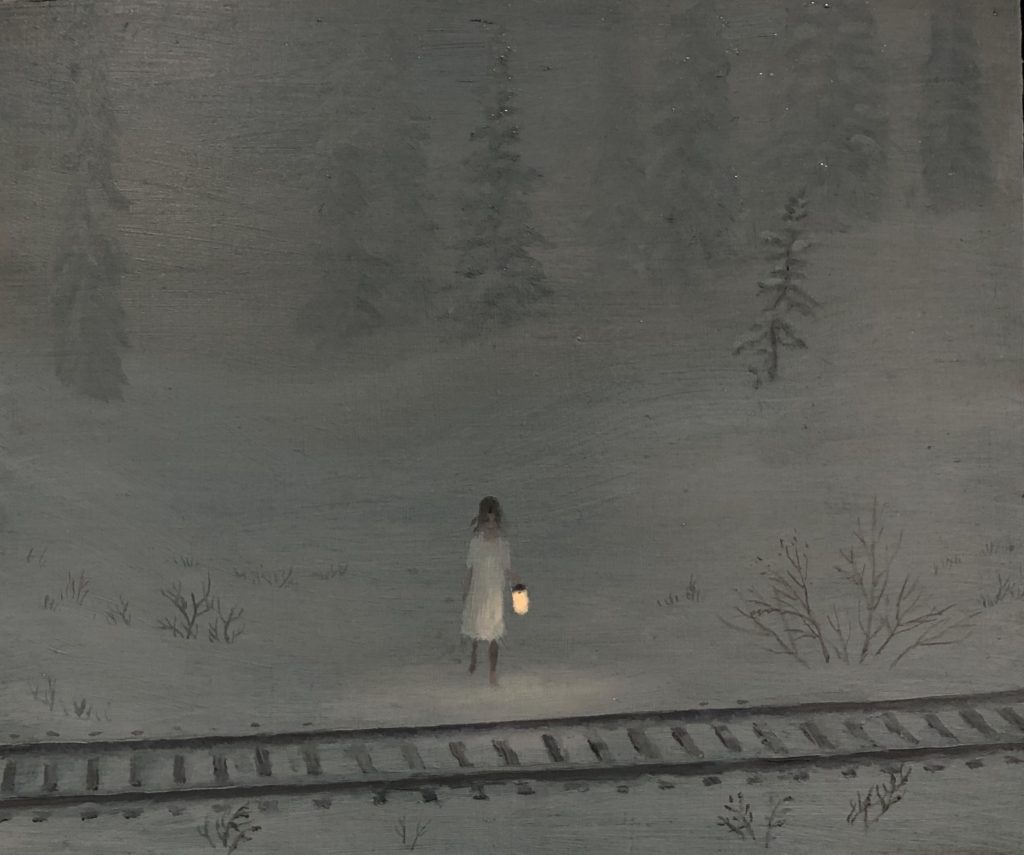Imagination’s worlds

A Late Arrival, Aron Weisenfeld, oil on panel.
At the risk of coming across as a human billboard for Arcadia Gallery, I have to note with pleasure a show that has already come down—with the same inadvertently useless timing of my last post on the gallery. Maybe this helps offset the impression that I’m standing on the street directing passersby through the front door, not that I would be ashamed to do that. On my last trip to the West Coast I was in California too early to see Matthew Cornell’s tour de force of small works, Roadside Attractions—(Manifest Gallery could do a solo installation of this same show entitled Magnitude 7, except that Cornell usually sells out whatever he shows). I arrived in time, though, to marvel at Aron Wiesenfeld’s Natural Selection, a haunting series of images that have a patina of somber fantasy, but are surprisingly vivid depictions of gentle, and sometimes intensely beautiful, alienation. His paintings are mostly centered around a young waif whose occasionally elongated figure reminds me faintly of Giacometti’s gaunt sentinels. Wiesenfeld creates scenes of almost hermetic silence, inwardness and isolation—all surrounding what look to be adolescent figures. Yet these qualities aren’t nightmarish, but are closer to tranquil waking dreams set in natural surroundings or sparsely populated urban landscapes. Illuminated signs beckon from a rural highway across an empty field or the glow of an Apple display logo shines like a candle from the lap of a teen sitting under a stone archway. His young, reflective figures seem slightly lost or just willfully unmoored from any recognizable purpose other than to be aware of their own superfluous presence in a world too busy or remote to notice them. (A mood known to most people, at any age, no?) This comes across as a good thing for us, at least—these figures become conduits for the viewer to variously absorb the intense beauty of the world immersing these idle avatars.
What’s so gripping about the work is how these almost stylized images awaken powerful, haunted feelings of familiar moods inspired by subtle qualities of light and even temperature that echo back through a viewer’s experience of countless winters or autumns, along highways, in woods. It’s a twilight world, alternating between wide, almost desolate open spaces (fringed with signs of random commerce) or protective havens for Wiesenfeld’s subjects: a reflecting pool, a tunnel, a crawl space or crumbling wall, and a beckoning pit. The images are like moments from disenchanted fairy tales, yet they aren’t depressing. They convey the not entirely unpleasant sadness one courts by listening to certain music in mid-teens, or twenties (or thirties for that matter)—when the joy of heartache can be a way of feeling most alive. Three paintings in the show have an almost mythical simplicity and resonance. His largest canvas, The Bridge, shows his waif standing on an old, improvised footbridge gazing off to the horizon dotted with lights from scattered commerce and low-rent homes clustering along a state highway. (It’s the sort of development that zoning boards relegate to places where those on the board wouldn’t build their homes, but in these paintings, there’s poetry in the yawning distance between the ruminating figure in the foreground and the winking points of light that shine at the far edge of the field.) One of the marvels of the painting is how everything looks illuminated exactly as it would under a full moon. The mood is one of fragile, forlorn expectation. The Pit shows a white robed figure, ghostly beside the black open mouth of a large well, or maybe just a firepit, but it feels more like a wormhole to the Black Forest. And a third depicts a single young watcher, patiently holding a lantern beside a rail line in the middle of an obscuring snowfall. She could be waiting to say hello, or lingering after a goodbye, or just loving the silent fall of the snow, though the title, A Late Arrival, tells the story. That little lamp illuminates an entire world, like the imagination itself, and though almost nothing is clearly distinguishable, everything in the picture seems just as it should be. As in most of these paintings the lonely figure is enveloped and sustained by the world they seem to establish around themselves simply by being at the imaginative center of it.
Comments are currently closed.